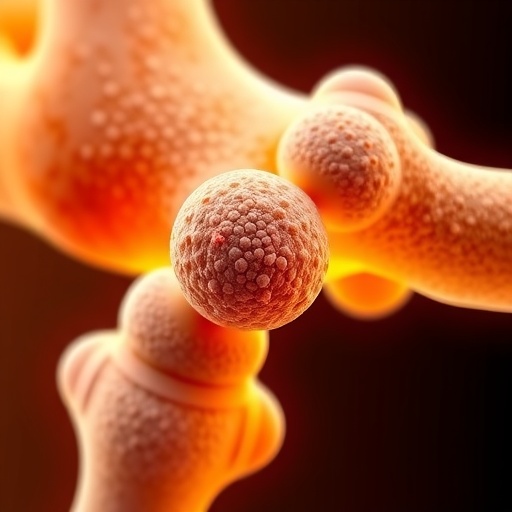
In a groundbreaking study published in the Annals of Biomedical Engineering, researchers have unveiled a new composite microsphere technology that promises to revolutionize the treatment of bone defects. Utilizing a novel combination of tannic acid-modified sodium alginate and chitosan, the study positions these microspheres as promising candidates for enhancing osteogenesis and biomaterial performance in regenerative medicine. This innovation not only addresses the structural integrity required for bone repair but also introduces multifunctionality that could have far-reaching implications in the field of tissue engineering.
Bone defects can result from various causes, including traumatic injuries, congenital abnormalities, or diseases such as osteoporosis. Traditional grafting materials, which often rely on autografts or allografts, face significant limitations including donor site morbidity and immune response complications. The introduction of biocompatible materials such as sodium alginate and chitosan provides a promising alternative as they are derived from natural sources and exhibit excellent biocompatibility and biodegradability. However, their limited mechanical strength and bioactivity often hinder their application in clinical settings. The innovative modification of these polymers with tannic acid aims to surmount these challenges.
The fabrication process of the tannic acid-modified sodium alginate/chitosan microspheres utilized a straightforward and scalable method. This involved the electrostatic assembly of the two polymers, resulting in a fine-tuning of the material properties. The incorporation of tannic acid not only enhances the mechanical properties, providing additional strength, but also imparts antimicrobial properties, an important feature in any scaffold used for regenerative purposes. The research team meticulously optimized the parameters of the fabrication process to ensure a uniform distribution of the components, crucial for achieving consistent performance across the microspheres.
Once fabricated, the new microspheres were subjected to an extensive battery of characterization tests. Properties such as surface morphology, porosity, and swelling behavior were evaluated to ensure that they met the stringent criteria for bone repair applications. Scanning electron microscopy revealed that the modified microspheres exhibit a porous structure that is conducive to cell attachment and growth. The porosity is vital as it facilitates the ingress of nutrients and waste products, creating a favorable microenvironment for bone regeneration. Additionally, their swelling behavior indicated excellent water retention, which is essential for maintaining an adequate environment for cell proliferation.
Biocompatibility is a critical factor when evaluating any new biomaterial for clinical applications. The research team conducted in vitro assays to assess cell viability and proliferation on the microspheres. Encouragingly, the results demonstrated that mesenchymal stem cells exhibit high viability and significant proliferation rates when cultured on these novel microspheres. This is a strong indicator that the tannic acid-modified sodium alginate/chitosan combination supports cell-friendly conditions, promoting effective healing processes.
Moreover, the multifunctional nature of these microspheres extends beyond mere structural support. The tannic acid modification introduces bioactivity that enhances the osteogenic differentiation of stem cells. In osteogenic differentiation studies, the treated cells showed increased expression of key markers associated with bone formation. This capacity to induce osteogenesis is paramount, as it suggests that these microspheres can actively participate in bone healing rather than simply serving as physical scaffolding.
An additional layer of innovation in this study lies in the antimicrobial properties imparted by tannic acid. The encapsulation of the modified polymers appeared to inhibit bacterial adhesion and proliferation significantly, reducing the risk of post-surgical infections—a common concern in bone repair surgeries. This antimicrobial effect enhances the overall functionality of the microspheres, positioning them as an attractive option for clinicians seeking to mitigate infection risks in patients undergoing bone repair procedures.
The integration of these multifaceted microspheres into clinical applications could redefine the standards for bone defect treatment. Their ease of fabrication, combined with their biocompatibility, bioactivity, and antimicrobial properties, makes them a versatile tool in the armamentarium of regenerative medicine. The potential for scaling up the production of these microspheres further enhances their appeal, offering a feasible path toward widespread clinical adoption.
Further research is warranted to assess the long-term performance of these microspheres in vivo. Initial studies will focus on evaluating the efficacy of these biomaterials in animal models. By understanding how these microspheres perform in a living organism, researchers can gain insights that may lead to optimized formulations for human applications. The integration of these innovative materials into existing treatment protocols could significantly improve outcomes for patients with bone defects.
Looking ahead, the findings from this research pave the way for future explorations into other bioactive modifications that could enhance the versatility of sodium alginate and chitosan composites. The pursuit of materials that can not only support but actively promote healing is at the forefront of tissue engineering. This opens the door for interdisciplinary collaborations aimed at refining and matching these materials to specific clinical needs.
Moreover, the broader implications of this research extend beyond bone repair. The principles outlined in this study regarding material modification and multifunctionality could inspire new approaches in various fields of biomedical engineering, including drug delivery systems and wound healing applications. The versatility of tannic acid as a modifying agent could inspire future innovation across biomedical applications.
As we usher in a new era in regenerative medicine, the research conducted by Kuang et al. serves as a reminder of the boundless potential for innovation in biomaterials. With ongoing advancements in understanding the biological interactions of these materials, the future looks promising for those in need of effective and safe treatment for bone defects.
This study is an affirmation that by harnessing natural polymers and enhancing their properties, it is possible to create materials that not only meet the demands of modern medicine but also push the boundaries of what is possible in tissue healing and repair.
In summary, the tailored microspheres crafted from tannic acid-modified sodium alginate and chitosan represent a significant leap forward in the field of bone defect repair. Through careful engineering and innovative thinking, researchers are laying the groundwork for more effective, safer, and multifunctional solutions that could transform patient outcomes in bone regenerative therapies.
Subject of Research: Multi-Functional Tannic Acid-Modified Sodium Alginate/Chitosan Microspheres for Bone Defect Repair
Article Title: Fabrication and Properties of Multi-Functional of Tannic Acid-Modified Sodium Alginate/Chitosan Microspheres for Bone Defect Repair
Article References:
Kuang, Z., Cai, X., Li, B. et al. Fabrication and Properties of Multi-Functional of Tannic Acid-Modified Sodium Alginate/Chitosan Microspheres for Bone Defect Repair. Ann Biomed Eng 53, 2080–2094 (2025). https://doi.org/10.1007/s10439-025-03796-x
Image Credits: AI Generated
DOI: https://doi.org/10.1007/s10439-025-03796-x
Keywords: Bone Defect Repair, Tissue Engineering, Biomaterials, Tannic Acid, Sodium Alginate, Chitosan, Microspheres, Biocompatibility, Osteogenesis
Tags: biocompatible materials for tissue engineeringbiodegradable polymer compositesbiomaterials in regenerative medicinebone repair technologieschallenges in clinical applications of grafting materialselectrostatic assembly in microsphere fabricationinnovative bone defect treatmentmultifunctional biomaterials for bone repairosteogenesis enhancement strategiessodium alginate and chitosantannic acid-modified microspheres




